A year ago, we shared tips on how to disinfect packages to protect against COVID-19. Since then, opinions have shifted, and some experts expressed concern over the practice. The CDC initially gave mixed messages, which we fact-checked and helped clarify, leading to a withdrawal of certain recommendations. Despite this, many of you still follow our earlier advice on package disinfection.
Recently, the CDC updated its stance on surface transmission of COVID-19, specifying that it accounts for less than 1 in 10,000 infections. Does this mean disinfecting packages is unnecessary? The community has been debating this, so here's our perspective:
- While the CDC's message remains somewhat unclear, the likelihood of contracting COVID-19 from surfaces seems minimal.
- Ultimately, it depends on your personal risk tolerance. If you're engaging in activities like dining out or visiting crowded places like Disney World, disinfecting packages likely won't make much difference.
- On the other hand, if you're being extra cautious due to vulnerable household members, disinfecting packages could be worth the effort.
- Interestingly, sunlight appears to be far more effective against the virus than we initially believed.
The CDC's advice continues to be somewhat contradictory. For instance:
- They state it's unclear how much surface transmission contributes to infections while simultaneously suggesting the risk is low, under 1 in 10,000.
- They acknowledge surface disinfection helps prevent spread within homes but discourage regular disinfection in public spaces.
- There's confusion around whether soap and water suffice or if EPA-registered disinfectants are necessary.
This feels like a compromise document reflecting differing opinions. Let’s focus on whether you should still disinfect packages.
In short: probably not. However, as always with COVID-19, it depends on your comfort level with risk. With around 31 million cases in the U.S., using the 1 in 10,000 statistic suggests only about 0.01% of infections result from surfaces. That means roughly 3,100 cases might have come from surfaces out of 31 million total.
Experts agree there’s a slight chance of surface transmission, albeit a very small one. The CDC confirms that SARS-CoV-2 survives longer on non-porous materials than porous ones, though exact durations vary. General guidelines suggest the virus lasts up to 24 hours on cardboard and up to 72 hours on nonporous surfaces. Yet, the latest report indicates the virus may degrade within minutes on some porous materials.
Packages often include non-porous items and at least a bit of tape, so quarantining them for three days before opening could still offer peace of mind. Here are my revised recommendations:
- If you're living life as usual, there's no need to disinfect packages.
- If high-risk individuals in your home are fully vaccinated, disinfecting packages probably won't provide significant benefit.
- If unvaccinated high-risk members live with you and you're taking extreme precautions, disinfecting packages might be worthwhile.
- Regardless, frequent handwashing or sanitizing, especially after touching foreign surfaces, remains crucial. Use a trusted hand sanitizer.
You may not even need to use disinfectant. Recent studies show SARS-CoV-2 is far more sensitive to sunlight than previously thought.
Sunlight vs. COVID-19
In our initial guide, we assumed sunlight wasn’t effective against SARS-CoV-2. However, new research from UC Santa Barbara challenges this notion. Lab tests found solar radiation inactivated the virus in 10 to 20 minutes, much faster than expected—up to 3 to 8 times quicker. Scientists are puzzled since SARS-CoV-2 seems more UV-B sensitive than any other known virus.
The prevailing theory is UV-A, a component of sunlight, plays a bigger role than anticipated. It's long been known UV-C, which doesn't occur naturally, effectively kills the virus but poses a human health risk.
Thankfully, sunlight appears more potent against SARS-CoV-2 than originally thought. If you're worried about a package, placing it in direct sunlight for half an hour could significantly reduce the already minuscule risk of infection. Turn the package to ensure all sides receive exposure, and if possible, open the box to let the interior and contents soak up the sun.

Square Cotton Pads,Cotton Square Pads,Facial Cotton Pads,Cotton Squares
COTTONWHISPER (TAIZHOU) DAILY PRODUCTS CO.,LTD , https://www.cottonwhipershop.com